
You can change the format, but the value is always the same. Unlike NOW(), however, it stamps the time as a fixed value. Like NOW(), it returns the current system time. When you need to save a permanent record of the current time, hold down the Control key and the Shift key while you type a semicolon ( ). NOTE: Someone who opens the worksheet in six months will see her own current date and time in this field, not the date and time that you saved the workbook.

Use this function when you need an always-updated current time in your calculations. Whenever you recalculate (or whenever Excel recalculates automatically because other cells have changed), the function pulls the time as of that moment. Regardless of how you format the display, however, the underlying value remains constant until you recalculate. If you want only the time and not the date, you can either format it as a time and pretend the date doesn’t exist, or you can use “=NOW()-TODAY()”, which subtracts the date portion and leaves only the time portion. You can reformat the result by right-clicking the cell, choosing “Format Cells,” and picking a different time format. NOW() returns the current date and time from your computer.

Explains some basic time formulas such as NOW() and TIME(),.How often have you looked at your watch and typed the current time into your worksheet? Or tried to convert from one time zone to another and produced an error? Or wondered why a time shows up looking like “0.9285”?įortunately, these questions are easy to answer once you understand how Excel time formulas work. By Christy Perry Categories: Advanced Excel


 0 kommentar(er)
0 kommentar(er)
